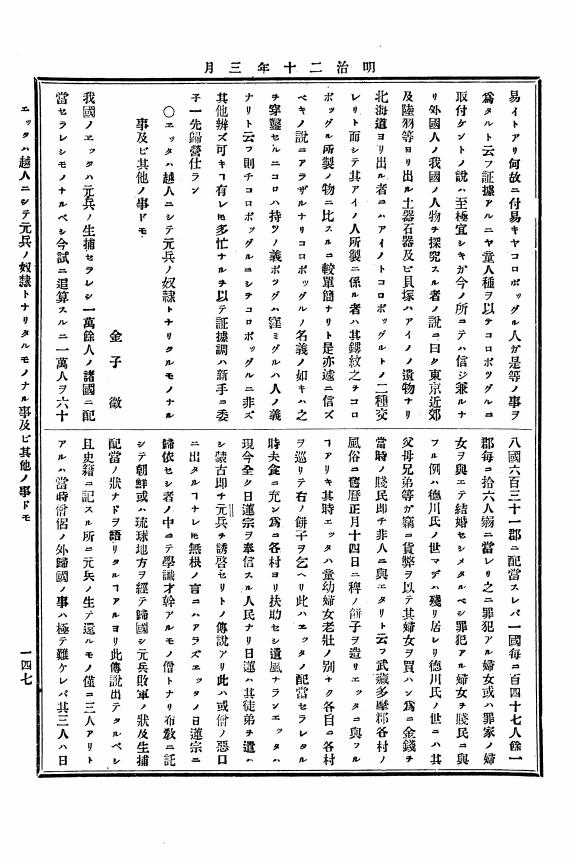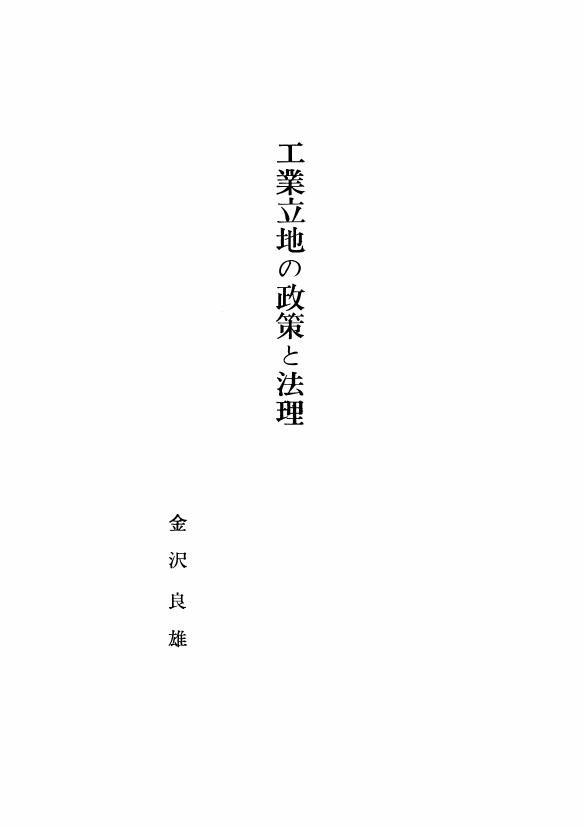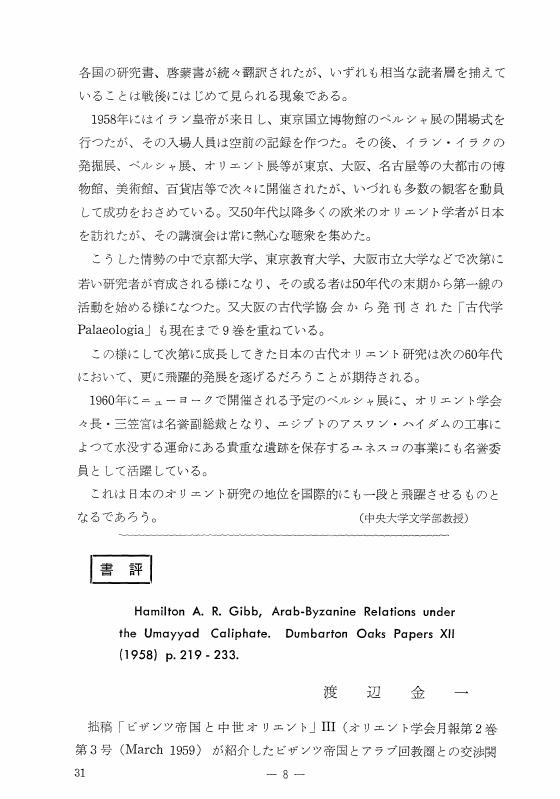1 0 0 0 OA エッタハ越人二シテ元兵ノ奴隷トナリタルモノナル事及ビ其他ノ事ドモ
- 著者
- 金子 徴
- 出版者
- 一般社団法人 日本人類学会
- 雑誌
- 東京人類學會報告 (ISSN:18847633)
- 巻号頁・発行日
- vol.2, no.13, pp.147-149, 1887 (Released:2010-06-28)
1 0 0 0 OA 日本及朝鮮ノ本國
- 著者
- 金子 徴
- 出版者
- 一般社団法人 日本人類学会
- 雑誌
- 東京人類學會報告 (ISSN:18847633)
- 巻号頁・発行日
- vol.2, no.12, pp.98-108, 1887 (Released:2010-06-28)
1 0 0 0 OA 一般的信頼についての質問は何を測定しているのか? 潜在クラス分析をもちいたアプローチ
- 著者
- 金澤 悠介
- 出版者
- 東北社会学会
- 雑誌
- 社会学年報 (ISSN:02873133)
- 巻号頁・発行日
- vol.48, pp.95-113, 2019-08-30 (Released:2021-02-26)
- 参考文献数
- 51
社会関係資本研究における重要性にもかかわらず,従来の一般的信頼の測定方法は大きな問題をはらんでいた.多くの経験的研究で使用されている測定法(一般的信頼性推定質問)において,「たいていの人」が誰を意味するのかが不明瞭なため,相矛盾する経験的知見が併存する状況となっていた.そこで,本研究は回答者によって一般的信頼性推定質問で想定する信頼のタイプが異なると考え,一般的信頼性推定質問の測定内容を検討した.『地域の絆と健康に関する調査』をもちいて,一般的信頼性推定質問・近隣住民への信頼・団体参加・協力行動を対象に潜在クラス分析を行ったところ,その意味内容が異なる4種類の信頼が抽出された.すなわち,(a)近隣住民を含む他者一般を信頼し,多様な他者とも関わるような団体参加・協力行動を促進する一般的信頼,(b)近隣住民のみを信頼し,居住地域に関わるような団体参加・協力行動を促進する地域主義的信頼,(c)社会的に望ましい回答をしたいという動機から一般的信頼性推定質問に肯定的に回答する非活動的信頼,(d)他者を信頼せず,団体参加・協力行動も活発ではない不信頼であり,社会的属性や居住地域によって回答者が想定する信頼のタイプが異なることも示された.そして,以上の分析結果をもとに,一般的信頼性推定質問の特性を議論するとともに,社会関係資本研究の知見の整理を試みた.
1 0 0 0 OA 地方公立大学における社会学教育の現状と課題 首都圏との比較をもとに
- 著者
- 金澤 悠介
- 出版者
- 東北社会学会
- 雑誌
- 社会学年報 (ISSN:02873133)
- 巻号頁・発行日
- vol.46, pp.101-105, 2017-12-26 (Released:2019-01-28)
- 参考文献数
- 3
- 著者
- 金菱 清
- 出版者
- 東北社会学会
- 雑誌
- 社会学年報 (ISSN:02873133)
- 巻号頁・発行日
- vol.41, pp.23-33, 2012-07-14 (Released:2014-03-26)
- 参考文献数
- 16
- 被引用文献数
- 1
本稿では,現代社会における「公正さ」について,単に近代国家の法律制度の枠組みへの位置付けだけでは公正性を保証できていないことを指摘したい.そのうえで,周りから不公平ともいえるものが実は逆に現代社会の公正性を担保することにつながっているという社会的事実を提示する. 拙著『生きられた法の社会学』において大阪国際空港(伊丹空港)の一角に形成された「不法占拠」地域について,その歴史的な形成プロセスと人々の生活の内実,そして,住民と伊丹市と国との交渉をとおして「不法占拠」が解消されていく経過を描き出した.そこで見出したものは,「剥き出しの生」を背負わされた人々の実践が実定法に包摂されない「生きられた法」を生成するとする「法外生成論」だった.法外におかれた人々の「エゴイズム」を排除するのではなく,人々の生活実践にこそ法の正統性の源泉があるとする主張は,グローバル化のもと,国家や市場から排除された人々が数多く生み出されている現在示唆的であると考えた. ただし,当初地震などの震災は,「生きられた法」からは除外していた.おもに阪神・淡路大震災を引き合いに出しながら,絶望的な極限状態の際に生じた公共性は,時間をおかず解消され,いずれ元の日常生活に戻っていく定点をもつという判断からであった.ところが3.11大震災において,「修正」を迫られる事態が発生した.むしろ「生きられた法」のなかに今回の大震災を含む方がしっくりくる.
1 0 0 0 OA 垂直的租税外部効果と経済成長
- 著者
- 金坂 成通 宮下 量久 赤井 伸郎
- 出版者
- 日本財政学会
- 雑誌
- 財政研究 (ISSN:24363421)
- 巻号頁・発行日
- vol.6, pp.118-130, 2010 (Released:2022-07-15)
- 参考文献数
- 19
わが国の地方分権改革でしばしば議論の対象となる国から地方への税源移譲に関して,その具体的方法を検討するために,垂直的租税外部効果が経済成長に与える影響について実証分析を行った。 推定結果から,垂直的租税外部効果は,経済成長の障害となっていることが示された。また,課税の裁量性に着目し,課税自主権を考慮した指標を用いた結果においても,垂直的租税外部効果は,経済成長を阻害することが確認された。これまで先行研究において,課税自主権の影響が示されていなかったが,本研究において,租税外部効果を通じた影響が新たに明らかとなった。 今後の地方分権に関する税財政論議でも,国から地方への税源移譲を実現するにあたって,民間の経済活動を妨げないように,課税ベースや税率選択において国と地方で過度の重複を避ける工夫が必要といえる。
1 0 0 0 OA 地方財政計画の変容にみる国の地方に対する財源保障の検証
- 著者
- 金目 哲郎
- 出版者
- 日本財政学会
- 雑誌
- 財政研究 (ISSN:24363421)
- 巻号頁・発行日
- vol.5, pp.315-334, 2009 (Released:2022-07-15)
- 参考文献数
- 11
過去四半世紀にわたる地方財政計画の変遷について,主要な歳出項目別の時系列分析を行い,近年の計画の抑制的見直しについて評価を加える。この分析過程では,各項目の算定根拠として積み上げられた施策・事業の変化に着目する。分析の結果,1990年代前半までの地方財政計画の膨張は単独事業分,なかでも長期計画事業や新規事業の増額計上が顕著である。1990年代後半以降の抑制・減少は単独事業分の圧縮によるが,新規事業の整理縮小のみならず過疎対策事業といった毎年計上事業分の圧縮,給与関係経費といった経常経費の減額にまで及んでいる。単独事業分のなかでもナショナル・ミニマムに関わるものの財源保障の削減は懸念され,マクロの財源保障に幅を持たせておくことは地域的に顕在化する行政需要に応える意味でも重要である。
1 0 0 0 OA 公営交通事業の効率化効果と要因の実証分析
- 著者
- 金坂 成通 倉本 宜史 赤井 伸郎
- 出版者
- 日本財政学会
- 雑誌
- 財政研究 (ISSN:24363421)
- 巻号頁・発行日
- vol.3, pp.160-183, 2007 (Released:2022-07-15)
- 参考文献数
- 22
現在,公営交通事業において過剰投資や非効率経営による問題点が指摘されている。今後は,民間同様の経営効率性を持って,民営化などの組織形態の変更も含めた改革が求められている。 本稿では,このような状況にある公営交通事業の中でもバス事業と地下鉄事業に対し,平成11年度から平成16年度までの年度間におけるマルムクイスト生産性変化指数を計測した。計測結果から,年度ごとに公営バス事業,地下鉄事業ともに各都市のマルムクイスト生産性変化指数にばらつきがあることがわかった。そして,マルムクイスト生産性変化指数の程度に影響を与えている要因を実証分析において検討した結果,公営バス事業の生産性の変化には,補助金が生産性変化指数を低下させる可能性,また経営基盤強化のための経営計画の実施が効果的である可能性が実証分析により示唆された。また,公営地下鉄事業については委託の促進が生産性変化に効果的である可能性が示唆された。
1 0 0 0 OA CIS経済統合の現状と展望
- 著者
- 金野 雄五
- 出版者
- ロシア・東欧学会
- 雑誌
- ロシア・東欧研究 (ISSN:13486497)
- 巻号頁・発行日
- vol.2006, no.35, pp.72-83, 2006 (Released:2010-05-31)
The aim of this paper is to examine the current status and future prospects of the regional economic integration among CIS countries.Firstly, the institutional framework of FTA and customs union among CIS countries is reviewed. Several plurilateral agreements towards establishing FTA and customs union were signed by CIS countries, but almost all of them have not been realized. On the other hand, a web of bilateral free trade agreements among CIS members is in effect. These agreements stipulate duty-free trade regime in all goods, while allow for some exemptions. Currently, such exceptional goods are very few in trade among 5 members of EvrAsES (Eurasian Economic Community) excluding Uzbekistan (i.e. Russia, Belarus, Kazakhstan, Kyrgyzstan and Tajikistan), though some NTB (nontariff barriers) remain. Concerning customs union, Russia and Belarus seemed to have succeeded in unifying tariff rates against the third countries in the latter half of 1990's, but some retreats are observed recently.Secondly, we examined two kinds of indices which represent the characteristics of intra-bloc trade. One is TII (Trade Intensity Index) and the other is HDLR (Horizontal Division of Labor Rate) Index. The results are following. Very high TII were observed with intra-CIS trade in 1996 and 2005, but the indices decreased during the period. In contrast, TII with EU and China were not so high, but increased. HDLR indices show the same trends. In many cases, the HDLR indices were higher in intra-CIS trade than in trade with non-CIS countries, but both of the indices decreased in the past decade. These trends of TII and HDLR seem to indicate the efforts toward CIS economic integration have had little effects on the flow of intra-CIS trade.Thirdly, we foresee the future prospects of CIS economic integration in relation to the process of entering WTO (World Trade Organization) . In that process, CIS countries are required to abolish all of the existing NTB, which will also contribute to the progress of FTA in the region. As for a customs union, the influence will be adverse. To sum up, it may be safe to foresee that the CIS economic integration will remain at the stage of FTA for several years in future.
1 0 0 0 OA 中ソ紛争と北韓: 1945年-1948年間の三角関係
- 著者
- 金 学俊
- 出版者
- THE JAPANESE ASSOCIATION FOR RUSSIAN AND EAST EUROPEAN STUDIES
- 雑誌
- ソ連・東欧学会年報 (ISSN:03867226)
- 巻号頁・発行日
- vol.1984, no.13, pp.126-133, 1984 (Released:2010-03-16)
- 参考文献数
- 3
1 0 0 0 OA 高田保馬博士のソ連共産主義批判の理・マルクス貧困論考 -高田博士生誕に寄せて-
- 著者
- 金田 良治
- 出版者
- THE JAPANESE ASSOCIATION FOR RUSSIAN AND EAST EUROPEAN STUDIES
- 雑誌
- ソ連・東欧学会年報 (ISSN:03867226)
- 巻号頁・発行日
- vol.1983, no.12, pp.94-106, 1983 (Released:2010-03-16)
1 0 0 0 OA ソ連におけるマーケティングと販売広告の最近の動向と展望
- 著者
- 金田 良治
- 出版者
- THE JAPANESE ASSOCIATION FOR RUSSIAN AND EAST EUROPEAN STUDIES
- 雑誌
- ソ連・東欧学会年報 (ISSN:03867226)
- 巻号頁・発行日
- vol.1981, no.10, pp.115-131, 1981 (Released:2010-03-16)
1 0 0 0 OA ソ連の資産再評価について
- 著者
- 杉本 金馬
- 出版者
- THE JAPANESE ASSOCIATION FOR RUSSIAN AND EAST EUROPEAN STUDIES
- 雑誌
- ソ連・東欧学会年報 (ISSN:03867226)
- 巻号頁・発行日
- vol.1978, no.7, pp.85-97, 1978 (Released:2010-03-16)
- 参考文献数
- 32
1 0 0 0 OA バルカン半島南西部の民族問題と地域統合 ―アルバニア人問題を中心に―
- 著者
- 金森 俊樹
- 出版者
- ロシア・東欧学会
- 雑誌
- ロシア・東欧学会年報 (ISSN:21854645)
- 巻号頁・発行日
- vol.1996, no.25, pp.91-98, 1996 (Released:2010-05-31)
- 参考文献数
- 27
1 0 0 0 OA 病院に勤務する看護師の組織阻害行動と情緒的コミットメント,自尊感情,肯定的気分との関連
- 著者
- 上野 瑞子 實金 栄 川田 裕次郎 柴田 展人
- 出版者
- 日本応用心理学会
- 雑誌
- 応用心理学研究 (ISSN:03874605)
- 巻号頁・発行日
- vol.45, no.1, pp.47-57, 2019-07-31 (Released:2019-10-31)
- 参考文献数
- 33
This study aimed at creating scales for measuring organizational retaliatory behaviors that would occur as a result of friction or conflict in human relationships between nurses in hospitals and may adversely affect patients, and finding the relationship of the organizational retaliatory behaviors with the emotional commitments and feelings of self-esteem.With 1439 nurses participating the survey, this study established a cause-and-effect model where the factors for nurse organizational retaliatory behaviors namely "enervation," "unskillfulness," "self-indulgence" were dependent variables, and feelings of self-esteem, emotional commitments, and affirmative feeling were the primary causes. Then, using the Structural Equation modeling, we examined if the model matched with the data. As a result, it was confirmed that the model matched with the data (CFI=0.945, RMSEA=0.049), suggesting that the factors reducing the organizational retaliatory behaviors should be considered.
1 0 0 0 OA 工業立地の政策と法理
- 著者
- 金沢 良雄
- 出版者
- 日本行政学会
- 雑誌
- 行政研究叢書 (ISSN:2187039X)
- 巻号頁・発行日
- vol.1964, no.5, pp.31-50, 1964-03-10 (Released:2012-09-24)
1 0 0 0 OA 爆発による巨大なファイアーボール
- 著者
- 金 佑勁
- 出版者
- 一般社団法人 日本燃焼学会
- 雑誌
- 日本燃焼学会誌 (ISSN:13471864)
- 巻号頁・発行日
- vol.62, no.201, pp.228-233, 2020 (Released:2020-09-26)
- 参考文献数
- 24
This paper reviews the features and hazards of large-scale fireball generated by accidental explosions. A catastrophic failure of storage vessel of flammable materials in a fire can lead to a fireball. The estimation of diameter and duration of fireball based on various experiments are discussed. The results calculated by empirical equations agreed reasonably well with the experimental data. The results demonstrated that the size and duration of the fireball depend on the mass of fuel. Additionally, in this article, the experimental investigations on fireball dynamics after rupture of 35 MPa and 70 MPa high-pressure hydrogen tank in a fire are described, and the results were used to validate the development of CFD model.
1 0 0 0 OA 方丈記と支那文學との關係 主として白樂天詩文との關係に就いて (昭和十七年一月例會報告)
- 著者
- 金子 彦二郎
- 出版者
- 日本学士院
- 雑誌
- 帝國學士院紀事 (ISSN:03879984)
- 巻号頁・発行日
- vol.1, no.1, pp.29-93, 1942 (Released:2007-05-30)
1 0 0 0 OA シンポジウム 古代オリエントにおける奴隷の問題
- 著者
- 渡辺 金一
- 出版者
- THE SOCIETY FOR NEAR EASTERN STUDIES IN JAPAN
- 雑誌
- 日本オリエント学会月報 (ISSN:18841384)
- 巻号頁・発行日
- vol.3, no.3, pp.31-36, 1960-06-05 (Released:2010-03-12)











